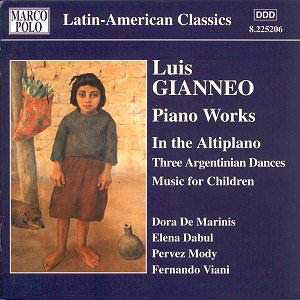The second volume of Luis Gianneo’s piano music spans
some fifteen years of his early creative life, the earliest piece dating
from 1931 and the most recent from 1947. Thus all pieces belong to Gianneo’s
Neo-classical period as is most evident in Música para
Niños (1946), Cinco Pequeñas Piezas
(1938) and Siete Piezas Infantiles (1946) which have much
in common with the delightful Sonatina of 1938 recorded
in the first volume (Marco Polo 8.225205).
Bailecito (1931), Dos Estudios
(1933) and Tres Danzas Argentinas (1938) still have some
folk-like tunes, particularly so in the Three Dances which at
times bring Ginastera’s early works to mind (or – rather - the other
way round!).
The prelude En el Altiplano (1932) is
the longest single item and also the most complex in this selection.
The basic material, though still somewhat folk-inspired, is worked out
in a more coherent and organised way.
Villancico (1946) and Caminito
de Belén (1947) are much simpler, more straightforward
miniatures of great melodic charm.
The first volume of Gianneo’s piano music includes
some major pieces such as the Second and Third Piano Sonatas that may
be somewhat tougher nuts to crack (though they are still very accessible),
whereas the works on offer in the second volume are more readily accessible
and, on the whole, provide for the best introduction to Gianneo’s attractive
and worthwhile music. Both are warmly recommended but Volume 2 is the
one to start with if you do not know Gianneo’s music.
Hubert Culot


![]() See
what else is on offer
See
what else is on offer 